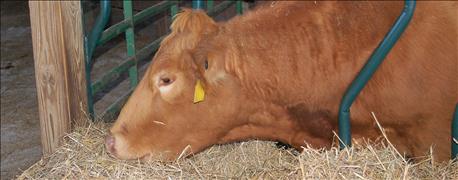
A case of tuberculosis was reported in Indiana in May. Bret Marsh, state veterinarian and head of the Indiana Board of Animal Health, says the situation is under control. He also says that it was an example of how protections in place can work to quickly identify sources of infected animals.
Here is a short update with Marsh.
IPF: It’s been reported that tuberculosis was discovered in a cattle herd in Indiana recently. Can you verify that?
Marsh: Yes. It was discovered on a farm in Franklin County in southeast Indiana.
IPF: How was it detected?

OTHER HERDS NOT LIKELY AT RISK: Tuberculosis was detected in a herd in Franklin County. Herds in other areas are not likely at risk, says Bret Marsh of the Indiana Board of Animal Health.
Marsh: It was an example of how the traceability system is supposed to work. The market where the producer sold the steers placed trace-back stickers on each animal. The animals were shipped to a packer in Pennsylvania. The packer keeps accurate records. After slaughter, lungs in six of the 11 animals showed scarring from six of the 11 steers. Since they had records through the trace-back tags, the packer could pinpoint which producer sold the cattle. Within a matter of hours we were talking to the producer. He was most cooperative.
IPF: What happens next?
Marsh: The herd that the infected cattle came from is being depopulated. We will also be testing all cattle within 3 miles of each of the two locations where the producer has cattle.
IPF: Will the producer be compensated for his loss, since cattle must be destroyed?
Marsh: Yes. USDA pays through an indemnification program. One thing that came out of the avian flu crisis in the Midwest in 2015 was an improved system for paying producers who lost livestock in these situations. He will be paid in a timely manner.
IPF: Who is responsible for paying for testing cattle of other producers in the area?
Marsh: BOAH will test other animals that had fence-line contact with the infected herd. Under state law, the county is responsible for paying for the rest of the testing. What normally happens is that the county is notified, and then local veterinarians assist in the testing and are compensated for their work.
IPF: Tuberculosis does not spread as quickly as highly pathogenic diseases, like avian flu, correct?
Marsh: That is correct. However, we still believe it’s prudent to test all cattle within a 3-mile radius of each location to determine if any other animals are infected.
IPF: Has this producer had cases of tuberculosis before?
Marsh: No. However, there was a case in the same general area in 2009.
IPF: Has the source of the infection been identified?
Marsh: No. We will be concentrating on doing what it takes to discover why it is showing up in that area.
IPF: Did premise identification play a role in this case?
Marsh: The producer has his proper premise ID information. However, we found him from the trace-back tags. The premise ID information in our database was very helpful in identifying where other cattle within the 3-mile radius areas were located.
IPF: Can technology help in tracking the source of infection?
Marsh: We hope so. USDA’s lab is capable of identifying tuberculosis by type today. That will let us know if it is the same type that has been identified in the area before. It should be very useful as we continue searching for the source.
About the Author(s)
You May Also Like




